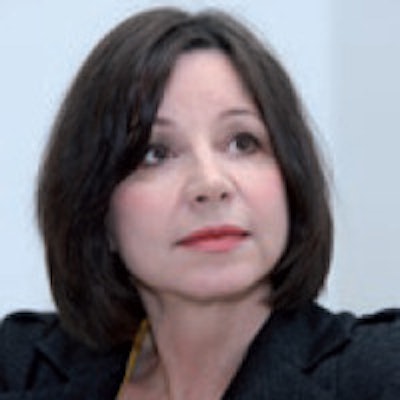
Audit is perceived by many as the boring counterpart to the more exciting "proper" research, which has more potential for publication. But audit is important and will become even more so in the future. Read the following interview with the chairperson of the European Society of Radiology's (ESR) Professional Organisation Committee, Dr. E. Jane Adam, to get some highly valuable insights into why we should all undertake audits, as well as some advice on how they can be planned and published. You will also find out how audit may even help you in an important interview.
Note: The following interview was originally published in ECR Today on 6 March 2014.
ECR Today: Why do we need audit, and why is it so important?
Dr. E. Jane Adam: Unless we sample and evaluate what we do in a critical way, we will never know how our departments are performing and how well and safely we are looking after patients. Audit allows us to be reassured about what we are doing to a satisfactory standard, and gives us information about where improvements should be made. Through reaudit we can then check that the anticipated improvement has actually been achieved.
 Dr. E. Jane Adam is a consultant in diagnostic radiology and honorary senior lecturer at St. George's Hospital in London. She chairs the ESR's Professional Organisation Committee and has previously served on a number of the society's other bodies. She is also a highly active member of the Royal College of Radiologists.
Dr. E. Jane Adam is a consultant in diagnostic radiology and honorary senior lecturer at St. George's Hospital in London. She chairs the ESR's Professional Organisation Committee and has previously served on a number of the society's other bodies. She is also a highly active member of the Royal College of Radiologists.
ECRT: Why should trainees choose to do an audit rather than a research project?
Adam: I am afraid it is not a case of choosing between them; trainees should do both. They are different, require different knowledge and skills, but experience with both can be carried through to the rest of your career. A familiarity with audit will ensure that you do not become complacent, but critically evaluate what you and your department do.
ECRT: How does audit differ around Europe?
Adam: Some countries have taken to audit with more enthusiasm than others. In fact clinical audit in relation to ionizing radiation exposure is mandatory under European Union legislation and there are European Commission guidelines on how to do it. The ESR has published an easy guide in Insights into Imaging (see references below), and is working on an audit handbook to help those just starting; but where people are used to it, it has become a routine part of practice.
ECRT: Some people think audit is boring. How can trainees or teachers find an exciting topic, even in a smaller hospital?
Adam: I am not sure that I can make it really exciting! However, it is very satisfying either to be able to say to your clinical colleagues or management that you have audited something and it is fine, or indeed to make a change and show things have improved. It certainly makes you look very professional. In a smaller hospital, changes can have quite a noticeable impact so it may be even more satisfying in a smaller hospital, or where a problem has been identified and solved, or indeed audit has highlighted the need for more investment in management. And of course, it is a good topic to discuss when you are interviewed for a more senior post, because you may know more about the topic than the interviewer, which is always good.
ECRT: Could you explain how an audit is planned and tell us what kind of pitfalls trainees should watch out for?
Adam: You can either identify something where there may be, or is perceived to be a problem, or important areas where vigilance is important such as radiation protection. You need to research what level of performance should be your target performance (sometimes this can be found in the academic literature, sometimes from published performance data, sometimes it just has to be consensus). Next you decide on your sample size, collect data, and see if you have reached the target. If you have, you can either relax or raise the target. If not, you need to think it through and implement changes and then reaudit. The main thing to remember is that audit must be collaborative and aimed at quality improvement. It should not be a weapon, or used as a way of assessing or criticizing others.
ECRT: What kind of audits do you think are publishable, and what kind of opportunities are there to get them published?
Adam: This is quite difficult, because audit is essentially a local process, but if there are genuine lessons or a very novel approach it may be publishable in a peer-reviewed journal. However, there are opportunities, for example there is an EPOS poster section at ECR for audit. The U.K. Royal College of Radiologists annual meeting accepts audit posters (and other national societies may have similar meetings accepting audit presentations/posters) and the two best are published in Clinical Radiology. The RSNA now accepts quality improvement "storyboards," which are essentially audits, and the authors of the best of these are invited to submit to Radiographics.
ECRT: Do you have any other tips on audit for trainees?
Adam: Start with something small and simple, and you will see how easy it is.
Further reading
- European Society of Radiology, ESR Subcommittee on Audit and Standards. Clinical audit -- ESR perspective. Insights Imaging. 2010;1(1):21-26.
- European Society of Radiology. European Commission guidelines on clinical audit. Statement by the European Society of Radiology. Insights Imaging. 2011;2(2):97-98.
- Royal College of Radiologists. AuditLive. Accessed via www.rcr.ac.uk. 2009.
Dr. Christiane Nyhsen is a consultant radiologist at Sunderland Royal Hospital in the U.K., a former chairperson of the European Society of Radiology (ESR) Radiology Trainees Forum, and a member of the AuntMinnieEurope.com Editorial Advisory Board.
Copyright © 2014 European Society of Radiology



















